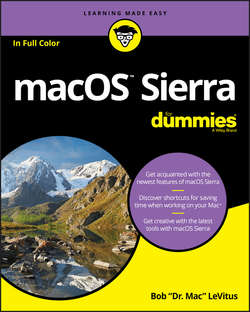Читать книгу macOS Sierra For Dummies - Bob LeVitus - Страница 5
На сайте Литреса книга снята с продажи.
Part 1
Introducing macOS Sierra: The Basics
Chapter 1
macOS Sierra 101 (Prerequisites: None)
Gnawing to the Core of macOS
ОглавлениеThe operating system (that is, the OS part of macOS) is what makes your Mac a Mac. Without it, your Mac is nothing but a pile of silicon and circuits – no smarter than a toaster.
“So what does an operating system do?” you ask. Good question. The short answer is that an OS controls the basic and most important functions of your computer. In the case of macOS and your Mac, the operating system
❯❯ Manages memory
❯❯ Controls how windows, icons, and menus work
❯❯ Keeps track of files
❯❯ Manages networking and security
❯❯ Does housekeeping (No kidding!)
Other forms of software, such as word processors and web browsers, rely on the OS to create and maintain the environment in which they work their magic. When you create a memo, for example, the word processor provides the tools for you to type and format the information and save it in a file. In the background, the OS is the muscle for the word processor, performing crucial functions such as the following:
❯❯ Providing the mechanism for drawing and moving the onscreen window in which you write the memo
❯❯ Keeping track of the file when you save it
❯❯ Helping the word processor create drop-down menus and dialogs for you to interact with
❯❯ Communicating with other programs
❯❯ And much, much more (stuff that only geeks could care about)
So, armed with a little background in operating systems, take a gander at the next section before you do anything else with your Mac.
One last thing: As I mention in this book’s Introduction (I’m repeating it here only in case you normally don’t read introductions), macOS Sierra comes with more than 50 applications in its Applications folder. Although I’d love to tell you all about each and every one, I have only so many pages at my disposal.
THE MAC ADVANTAGE
Most of the world’s personal computers use Microsoft Windows (although more and more people are switching to the Mac). But you’re among the lucky few to have a computer with an OS that’s intuitive, easy to use, and (dare I say?) fun. If you don’t believe me, try using Windows for a day or two. Go ahead. You probably won’t suffer any permanent damage. In fact, you’ll really begin to appreciate how good you have it. Feel free to hug your Mac. Or give it a peck on the disc drive slot (assuming that your Mac has one; most, including the MacBook, MacBook Air, and Mac mini at this writing, don’t). Just try not to get your tongue caught.
As someone once told me, “Claiming that macOS is inferior to Windows because more people use Windows is like saying that all other restaurants serve food that’s inferior to McDonald’s.”
We might be a minority, but Mac users have the best, most stable, most modern all-purpose operating system in the world, and here’s why: Unix, on which macOS is based, is widely regarded as the best industrial-strength operating system on the planet. For now, just know that being based on Unix means that a Mac running macOS will crash less often than an older (pre-OS X) Mac or most Windows machines, which means less downtime. Being Unix-based also means getting far fewer viruses and encounters with malicious software. But perhaps the biggest advantage macOS has is that when an application crashes, it doesn’t crash your entire computer, and you don’t have to restart the whole computer to continue working.
By the way, since the advent of Intel-powered Macs a few years ago, you can run Windows natively also on any Mac powered by an Intel processor, as I describe in Chapter 20. Note that the opposite isn’t true: You can run Windows on your Mac if you care to, but you can’t run macOS on a Dell or HP (or any other computer not made by Apple), at least not without serious hacking (which is technically illegal anyway).
And don’t let that Unix or Windows stuff scare you. It’s there if you want it, but if you don’t want it or don’t care (like most users), you’ll rarely even know it’s there. In fact, you’ll rarely (if ever) see the word Unix or Windows again in this book. As far as you’re concerned, Unix under the hood means your Mac will just run and run and run without crashing and crashing and crashing. As for Windows, your Mac can run it if you need it; otherwise, it’s just another checklist item on the list of reasons Macs are better than PCs.
